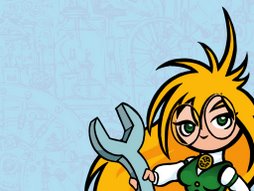 I've been enjoying Countdown, really I have. I'm enjoying it more since it's editorial change-over, but I have been liking it since the beginning. But...
I've been enjoying Countdown, really I have. I'm enjoying it more since it's editorial change-over, but I have been liking it since the beginning. But...Let's go back several years. We've got a DC Universe that's fairly cohesive and where things fit together. Problem is, it's more than a bit dark. I'm not really sure how this happened. After the original Crisis On Infinite Earths, things were much lighter in tone. We had the JLI, which was very light, almost to the point of being a humor book. This lasted a while, including various spin-offs, but eventually it was gone, replaced by the darker and more serious JLA. Which then broke up and was reformed. Which then broke up and was...
Batman, somewhere in here, lost his way, and he became almost the epitome of dark. New black costume, his back broken (by Bane), and his city destroyed, there was, for me at least, no reason left to read his titles any more. It was a relentlessly depressing and out-of-touch reality.
The "Post-Crisis" Superman was also lighter in tone, concentrating more on the mythic than on the dark. That started changing when we hit the era of the "Death of Superman". Somehow, once we were through that, things were never the same. The stakes had been raised, and things were ever-darker.
Green Lantern's city was destroyed in the course of the Superman epic, and it drove him mad. He, well, changed, and became the villain Parallax. As Parallax he tried to remake the universe. He partially succeeded. What came out of it wasn't the universe he'd wanted, but it was somewhat different, and darker still than the previous iteration. Eventually he redeemed himself saving the earth, and died, only to eventually become the Spectre. Actually his death caused Hal Jordan to become less dark. His Spectre was more a creature of redemption than of punishment. So, of course, that promptly ended and he went on to his not-so-eternal reward.
I could continue on, itemizing the roster of the DC Universe, but why? Hopefully by now you get the idea. As time went on, the universe continued to darken, and the heroes went from heroic to, well, I'm not quite sure how to describe it. Between personal tragedies (such as the new Green Lantern's girlfriend being murdered and her body stuffed into a refrigerator for him to find) to less-than heroic behavior (such as Power Company, the super-team that was just in it for the money).
Things hit their nadir when the "Identity Crisis" struck. Instead of a 'cosmic' type crisis, this one was personal and much closer to home. Sue Dibny, the Elongated Man's wife, was murdered in their home, and all indications were that it was done by one of the Justice League's villains. As things developed, we discovered that the League had been doing some less-than-heroic things for quite a while, mindwiping villains and making them more than a little bit ineffectual. THEN it turns out that they did it to Batman, as well!
The upshot was a further darkening of the DC Universe. The original, 1930's era Superman, who was still alive off in a pocket universe, was increasingly angered and disappointed in what he saw happening, and took steps to fix things. Of course, things didn't go to plan, but the world was once again remade in the Infinite Crisis.
A major goal of this partial reboot was to 'lighten up' the tone of the heroes, and to return them to being, well, more heroic. In some ways it worked. The Justice Society disbanded and then restarted, this time with the idea of 'making better heroes'. It made incremental differences in Batman, returning him to gray and lightening him up a fraction. Others, though...
In the run-up to the crisis, Wonder Woman killed a villain, Maximilian Lord. Not by accident, but intentionally. That didn't change in the soft reboot. The intention was there for the universe as a whole to lighten up, but somehow the changes rapidly went by-the board. The first year after the crisis was skipped over, in favor of showing a 'One Year Later' universe where the changes had shaken down. Regrettably, they basically settled down to the status quo ante. Aside from the characters involved in 52 you'd have hardly known a year had passed. Out of 52 we learned that the changes in Infinite Crisis were more extensive than we'd thought, though not 'here at home'. There were 52 different but identical universes. Mr. Mind, though, managed to disrupt the fabric of spacetime, and all the worlds changed -- so we now have 52 parallel universes.

In Countdown, we're seeing something -- something? -- going on that's going to change and redefine the DC Multiverse. Again. And we already know that following Countdown is Final Crisis.
I'm really hoping that Final Crisis is, in fact, final. We've had several years of flux that's taken a well-ordered universe, albeit one which is way too dark, and created an amorphous mish-mash of realities. It was roughly twenty years between Crisis On Infinite Earths and Identity Crisis. Since Identity Crisis it's been a headlong rush from crisis to crisis.
I believe it's getting past time for some closure. What I want to see coming out of Final Crisis is a well-ordered universe that can be used as a good sandbox for telling stories. After several years of flux, it's getting tiring to try and keep track of who's who and what's what. I think DC is at the point of diminishing returns with the whole "Crisis" concept. It's time to wrap this up and move on to other kinds of stories.
If they want to do another cosmic redefinition, how about putting it on the schedule for, roughly, 2028?

